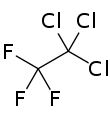| |||
| Names | |||
|---|---|---|---|
| Preferred IUPAC name
1,1,1-Trichloro-2,2,2-trifluoroethane | |||
| Other names
CFC-113a Freon 113a Arcton 63 Freon-FT 1,1,1-Trichloro-2,2,2-trifluoroethane 1,1,1-Trichlorotrifluoroethane 1,1,1-Trifluoro-2,2,2-trichloroethane 1,1,1-Trifluorotrichloroethane CF3CCl3 FC 113 FC133a Precision cleaning agent TF T-WD602 Trichlorotrifluoroethane unsymmetrical FC 113a 2,2,2-Trichloro-1,1,1-trifluoro-ethane | |||
| Identifiers | |||
3D model (JSmol) |
|||
| ChemSpider | |||
| ECHA InfoCard | 100.005.968 | ||
| EC Number |
| ||
PubChem CID |
|||
| UNII | |||
CompTox Dashboard (EPA) |
|||
| |||
| |||
| Properties | |||
| CCl3CF3 | |||
| Molar mass | 187.376 g/mol | ||
| Appearance | Colourless liquid | ||
| Density | 1.579 g/mL[1][2] | ||
| Melting point | 13–14 °C (55–57 °F; 286–287 K) | ||
| Boiling point | 46 °C (115 °F; 319 K) | ||
Except where otherwise noted, data are given for materials in their standard state (at 25 °C [77 °F], 100 kPa).
Infobox references | |||
Asymmetrical trichlorotrifluoroethane, also called 1,1,1-Trichloro-2,2,2-trifluoroethane or CFC-113a is a chlorofluorocarbon (CFC). It has the formula CCl3CF3.
Environmental effects
Ozone depletion
A team of researchers at the University of East Anglia analysed unpolluted air samples from Tasmania dating from the period 1978 to 2012. They concluded that the CFC's they studied had started entering the atmosphere from anthropogenic sources in the 1960s and that while the abundance of certain CFCs had decreased, owing to the Montreal Protocol, the abundance of CFC-113a in the atmosphere was still growing.[3] Its source remained uncertain, but production of hydrofluorocarbons in East Asia was suspected by some.[4] Between 2012 and 2017, concentrations of the gas jumped by 40 percent.[5] In 2020, the global mean concentration of CFC-113a was 1.02 ppt with global emissions of 2.5 ± 0.4 ODP-Gg yr−1.[6]
See also
References
- ↑ "1,1,1-Trichlorotrifluoroethane". chemblink.com. Retrieved 10 March 2014.
- ↑ "Material Safety Data Sheet : 1,1,1-Trichlorotrifluoroethane". fishersci.com. Archived from the original on 10 March 2014. Retrieved 10 March 2014.
- ↑ Laube, Johannes C.; Newland, Mike J.; Hogan, Christopher; Brenninkmeijer, Carl A. M.; Fraser, Paul J.; Martinerie, Patricia; Oram, David E.; Reeves, Claire E.; Röckmann, Thomas; Schwander, Jakob; Witrant, Emmanuel; Sturges, William T. (9 March 2014). "Newly detected ozone-depleting substances in the atmosphere" (PDF). Nature Geoscience. 7 (4): 266–269. Bibcode:2014NatGe...7..266L. doi:10.1038/ngeo2109. S2CID 140544959.
- ↑ McGrath, Matt (9 March 2014). "Mysterious new man-made gases pose threat to ozone layer". BBC News. Retrieved 10 March 2014.
- ↑ Adcock, Karina; Reeves, Claire; Gooch, Lauren; Leedham Elvidge, Emma; Ashfold, Matthew; Brenninkmeijer, Carl; Chou, Charles; Fraser, Paul; Langenfelds, Ray; Mohd Hanif, Norfazrin; O'Doherty, Simon; Oram, David; Ou-Yang, Chang-Feng; Phang, Siew Moi; Samah, Azizan Abu; Röckmann, Thomas; Sturges, William; Laube, Johannes (9 April 2018). "Continued increase of CFC-113a (CCl3CF3) mixing ratios in the global atmosphere: emissions, occurrence and potential sources". Atmospheric Chemistry and Physics. 18 (7): 4737–4751. Bibcode:2018ACP....18.4737A. doi:10.5194/acp-18-4737-2018.
- ↑ Western, Luke M.; et al. (3 April 2023). "Global increase of ozone-depleting chlorofluorocarbons from 2010 to 2020". Nature Geoscience. 16 (4): 309–313. Bibcode:2023NatGe..16..309W. doi:10.1038/s41561-023-01147-w. hdl:1983/9e103fef-e61c-49c7-a1a3-902540ec1d7c. S2CID 257941769.

